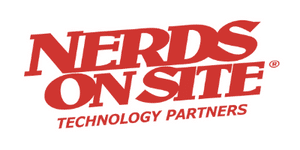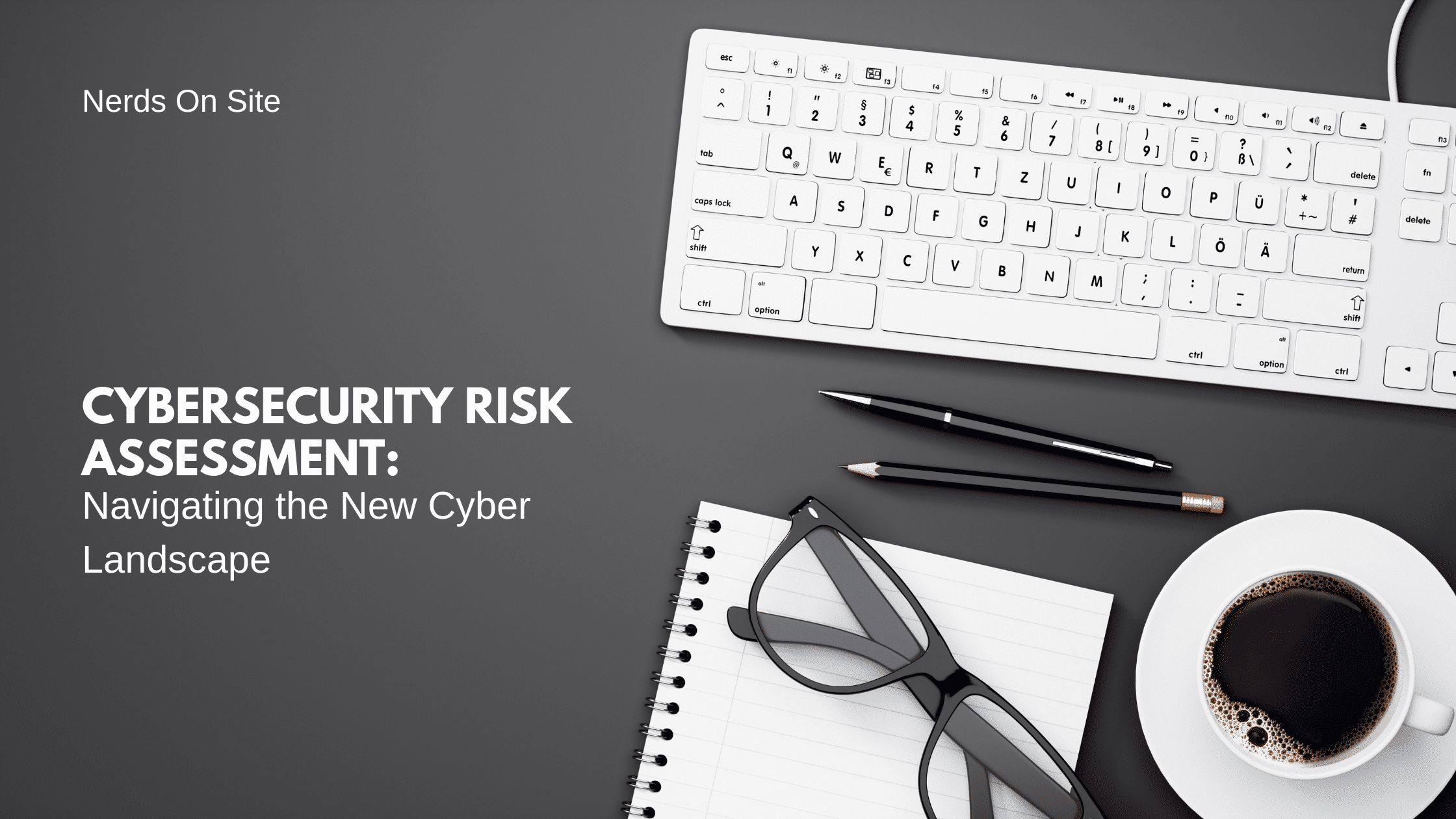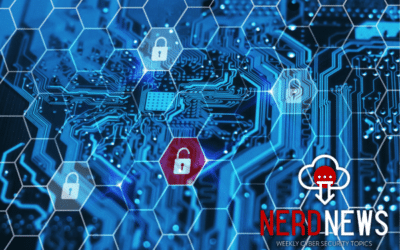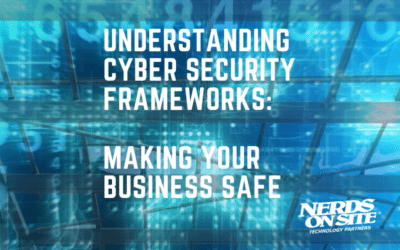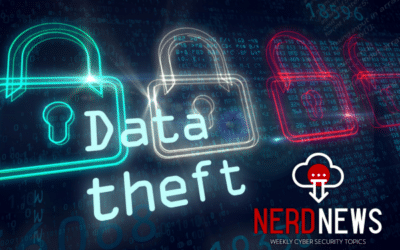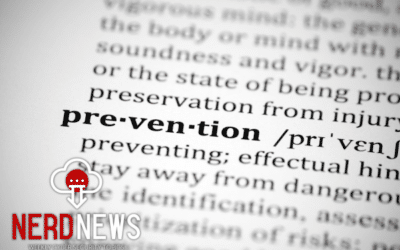What are cybersecurity risk assessments?
A cybersecurity risk assessment is a process that allows an organization to identify, understand, and prioritize the cybersecurity risks to its business. The goal of the risk assessment is to develop a risk management plan that will mitigate the most significant risks.
Article Contents
This article will provide you with the resources and information needed to create and implement a cybersecurity risk assessment framework, but we recommend using a professional. Nerds On Site can provide you with a comprehensive, non-invasive cybersecurity risk assessment to help you navigate your cyber risk landscape while providing easy-to-understand reporting on the next steps required to secure your business.
Does my business need cyber risk assessments?
A risk assessment is an essential part of protecting your business against cybercrime. By understanding your business’s risks, you can protect your data and systems.
A core reason for a cyber security risk assessment is information security risks, which are the potential threats to the confidentiality, integrity, and availability of an organization’s information assets. Information assets can include anything from confidential customer data to company trade secrets. There are a variety of different ways that an organization can be vulnerable to information security risks, including:
- Phishing attacks
- Malware infections
- Spearphishing attacks
- Data breaches
- Social engineering attacks
A good risk assessment process will identify potential threats, identify vulnerabilities, and recommend steps to reduce your risk. It’s important to remember that no system is 100% safe from attack, but you can make it much more difficult for criminals to steal your data or damage your plans by taking precautions.
How do I conduct cyber risk assessments?
The risk assessment process has several steps, including:
Identifying the organization’s IT assets and the data they contain
The first step in any risk assessment process is identifying the organization’s IT assets and the data they contain. This includes everything from the organization’s servers and computers to its mobile devices and e-mail systems. It’s essential to identify all of these assets and understand how each one is used so that you can understand the potential risks involved.
Assessing the vulnerabilities of these assets and the threats to them
Once you’ve identified the organization’s IT assets and the data they contain, you need to assess the vulnerabilities of these assets and the threats to them. This includes identifying any potential weaknesses in the system and understanding the dangers posed by internal and external threats. It’s essential to have a clear understanding of both the risks and the potential consequences to develop an effective risk management strategy.
Develop a plan to mitigate or eliminate the risks.
Once you have identified the risks, you must develop a plan to mitigate or eliminate them. This may include deploying additional security controls, changing processes or procedures, or hiring additional staff. There is no one-size-fits-all solution to cybersecurity risk. Every organization is different and will require a unique approach to managing these risks.
Implementing the plan and regularly monitor and update it
Once you have created your plan, it is essential to implement it and periodically monitor and update it. This will help ensure that your data is protected from cyber-attacks. By regularly updating your plan, you can ensure that your security controls are adequate and that your organization is always prepared for the next attack.
Several well-known frameworks have been developed to help organizations conducting cybersecurity risk assessments, including:
NIST Cybersecurity Framework
The National Institute of Standards and Technology (NIST) Cybersecurity risk management framework provides organizations with a prioritized, flexible, and cost-effective approach to assessing and managing cybersecurity risk. The Framework is voluntary, and it enables organizations to identify their own cybersecurity needs and make informed decisions about how best to protect their systems and data.
The NIST Cybersecurity Framework consists of five core functions: identity, protect, detect, respond, and recover. It also includes three categories of cybersecurity risk: business risk, technical risk, and legal risk. Each category has specific sub-risk factors that organizations can prioritize their cybersecurity risk management efforts.
ISACA Risk IT Framework
The ISACA Framework is a complementary framework that provides additional detail on applying the NIST Cybersecurity Framework. The Risk IT Framework includes specific guidance on identifying and assessing cybersecurity risk, protecting information and systems, detecting incidents, responding to incidents, and recovering from incidents.
Both frameworks provide a common language for organizations to discuss cybersecurity risks with their partners and suppliers. By using these frameworks, organizations can improve communication and collaboration around cybersecurity risk management.
ISO 27005 Information Security Risk Assessment Standard
ISO 27005 is a risk management process standard that identifies, assesses, and manages cybersecurity risk. The standard includes a risk management framework and best practices for implementing a risk management program.
The standard is based on the ISO 31000 risk management standard, which provides a framework for managing risks of all types. The ISO 27005 risk management process standard is specific to cybersecurity risks, and it guides how to identify, assess, and manage those risks.
Organizations of all sizes and industries can use the standard. It provides a common language for organizations to discuss cybersecurity risks with their partners and suppliers.
CIS Critical Security Controls
The Critical Security Controls (CSC) is a prioritized list of actions organizations can take to protect their systems and data from cyber threats. The CSC was developed by a consortium of information security professionals at the Center for Internet Security (CIS).
The CSC is based on the best practices of leading security experts and organizations. They are updated regularly to reflect the latest threats and vulnerabilities.
The CSC is divided into five categories:
- Control Categories
- Control Groups
- Control Sets
- Baseline Controls
- Tailored Controls
The CSC is intended to be implemented in its entirety. They can help organizations identify risk areas and prioritize the controls that will benefit the least cost.
Nerds On Site is a registered partner of the Center for Internet Security and employs the framework in our assessment models.
Breakdown of cybersecurity risk assessments steps
Network & Devices
Inventory all business-owned devices, including monitors, workstations, laptops, tablets, smartphones, printers, and other peripherals. Identify which ones are connected to the network and what kind of connection they use (wired vs. wireless).
Create a list of all connected devices and store it electronically in a spreadsheet or database.
Assess the security of each device, including its operating system and applications, patches and updates installed, firewalls enabled, antivirus software installed, and other security features.
Network Configuration
Check the network configuration to ensure that all devices are appropriately segmented into different virtual LANs (VLANs). VLAN technology uses software to group devices based on their physical location, function within the organization, or security requirements.
Network Diagram
Draw a network diagram that shows the layout of your business’s local area network (LAN) and Wide Area Network (WAN).
Applications
Create a list of all applications installed on the network, including their purpose and source. Also, create a list of any custom-developed applications.
Assess each application’s security, including its operating system, installed patches/updates, and other security features.
Database Security
Check the security of your organization’s databases, including the type of database software (e.g., Microsoft SQL Server, Oracle Database), patch level, and security configuration.
Review the access control list (ACL) to ensure that only authorized users can access the data. Review user privileges to ensure that each user has the minimum required privileges.
Email Security
If you have local email servers, check the security of your organization’s email servers, including patch level and email gateway—review permissions to ensure that only authorized users can access the data.
Enable DMARC & SPF to prevent spoofing your organization’s email domain.
Ensure DKIM is enabled to sign all outbound emails.
TLS is a critical component of email security and should be enabled to encrypt all communications between the e-mail server and the client.
Quarantine new devices joining the network.
When a new device joins the network, quarantine it until it can be checked for malware and other security threats. This can be done using a Zero Trust solution, which uses various methods, including device profiling and machine learning.
Regularly tested & encrypted backups.
Create a backup schedule that mirrors your organization’s needs. Ensure the backups are tested regularly to be restored in an emergency.
Ensure the backups are stored securely, such as an encrypted backup server or cloud storage service. Ensure that only authorized users can access the backups.
Cybersecurity policies & procedures
Develop and implement cybersecurity policies and procedures that address your organization’s specific needs, such as password policies, device use policies, and incident response plans.
One of the most important aspects of maintaining cybersecurity is training employees on using the policies and procedures. This helps ensure that they understand their role in keeping the organization secure. It is also essential to regularly review and update the policies and procedures to ensure that they are always up-to-date.
Multi-Factor Authentication
A cybersecurity risk assessment will always require Multi-factor authentication (MFA); if you do not already utilize MFA where enabled, you should research and implement it immediately. MFA requires two or more factors to verify a user’s identity, such as a password and a security token.
Security Awareness Training
One of the essential aspects of cybersecurity is training employees to stay safe online. You should conduct regular training for employees on phishing, social engineering, and ransomware. This will help employees identify and avoid threats and respond if a cyberattack targets them.
Cyber Insurance Review
Cyber insurance is a must for any business. Review your policy to ensure you have adequate coverage. Cyber insurance can help with business interruption and crisis response. Also, ask about additional services available to you, such as forensics and legal support.
Dark Web Monitoring
One way to protect your organization from cyberattacks is to use a service that monitors the dark web for stolen credentials and other sensitive information that could be used to attack your organization. This service can help you proactively protect your organization by identifying any leaked data that could be used in an attack.
Regular Penetration Testing & Vulnerability Scanning *Advanced*
Perform regular penetration tests and vulnerability scans to identify your network and systems vulnerabilities. Use the results of these tests to prioritize your organization’s security efforts.
It is always a good idea to use a qualified third-party vendor for these services, as they will have the expertise and experience to help your organization stay secure.
Conclusion
Cybersecurity is a big problem for small and medium-sized businesses. We all know that cyberattacks are on the rise, but many SMEs don’t have the resources to pay high monthly subscription fees for traditional security solutions.
The Nerds On Site SME Edge with patented Zero Trust AI technology automatically secures all of your business data against hackers, ransomware, or phishing attacks. Additionally, we can guarantee 99.999% uptime and even provide managed business-grade networking equipment and secure encasement that makes it easy to get up and run without any technical expertise. If you’re looking for a simple way to secure your business, contact us today.
